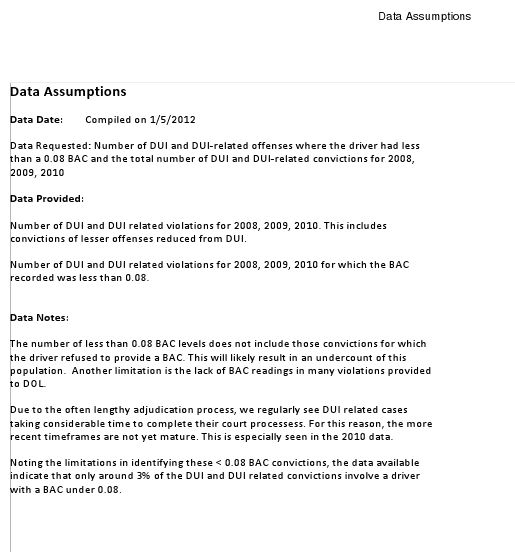How Washington State Circumvents the Fourth Amendment and the .08 Threshold for the Signs They Post as Limit; A Statistical Analysis in but One State
We live in a state that advertises with signs and with many government agencies that the limit for alcohol consumption is .08% while operating a motor vehicle. I would also like to add that nobody condones drinking and driving. But this is not the subject matter or the point of facts.
Read through the articles or watch the headline news, and you will find that drinking and driving continues to be a problem in Washington State. There are many tragic accidents and many needless deaths associated with drinking and driving. This much is true. But amongst these sad statistics, perhaps hidden from public view, lurks other statistics.
I wanted to look further into justice, for the sake of justice, and I wanted to see for myself an unbiased view of information that goes beyond the drunken stupor of driving in the wrong direction on the freeway, or needlessly killing people or injuring others.
There is great talk of making stiffer penalties for Driving Under the Influence and for Vehicular Homicide and for this I wanted to look into some statistics before any further debate. These are serious charges and crimes. They are not to be taken lightly.
Before any debate takes place, it is important to review these statistics, for the sake of statistical analysis, but also for the sake of justice and fairness. It is our lawmakers responsibility to write just and rational laws, but from the statistics gathered from the Washington State Department of Licensing, they paint a picture of uncertainty and potentially many cases of legal limbo based upon irrational law making, based on no standard that is generally made public to the citizens of this state, and for that, I wish to present the facts. The people of the State of Washington deserve an OPEN and TRANSPARENT GOVERNMENT.
The purpose of this essay is to describe the many statistics as it relates to Driving Under the Influence for alcohol related incidents only and for those over 21 only, so as to not confuse different standards and situations, while the purpose also intends to analyze this data as it relates to the discussion of whether stiffer penalties need to be imposed further with regard to Driving Under the Influence and Vehicular Homicide, or whether to argue that the current laws are disingenuous and that there are no clear standards in place at current time, let alone warranted for further discussion of increased penalties, meaning stiffer sentencing guidelines and prison sentences.
I will argue that these statistics will show the unfairness and legal jeopardy citizens could face, including many innocent citizens, and that the entire subject matter and law making process needs to be revisited, redone, and based on clear and concise data. Given the costs and what is at stake, I think this subject matter warrants that.
As I stated, one would think that the laws for DUI are clear. After all the media says the DUI limit is .08%. The signs say .08% LIMIT, but then just review the statistics and ask yourself what comes into question should they move towards stiffer penalties and increased enforcement. Perhaps the statutes should be lowered to Zero Tolerance, or perhaps a lower standard such as .05%, but I think this is reasonable based on the statistics reviewed. There needs to be a clear law and officer discretion should be removed to eliminate the conflict of interest. That goes for the courts too.
The other point I would like to make is the amount of cases in the state for 2008, 2009, and 2010, based on the statistics reviewed. When you match up the statistics with Prosecutor’s recommended guidelines for sentencing, one must also consider the amount of hours for all involved, the budgets, the amount of human resources, lawyer time and lawyer bills, and all else involved. But these statistics will speak for themselves, and then it is fair for the argument to begin.
These statistics are for all DUI’s in 2008, 2009, and 2010. Again all are for those individuals over 21 and alcohol related only. These statistics alone are for those under the .08 so called “limit”.
The DOL has provided the statistics, and they speak volumes. I need not add commentary. But there are a few things worth explaining first. The convictions for DUI’s, as reported back to the DOL by the courts paint part of the picture, but not all of it. Not all of the 2010 court cases are finished, so therefore that information is not included for that reason, so it is not 100% accurate. Another factor to consider, according to the DOL, is that “This is due (to) charges being reduced from DUI to some lesser charge (there are more than 100 different types of alcohol-related charges that get posted to people’s records here at DOL and many do not carry any information about BAC.”
Here is the Data Assumptions as provided by the DOL:


What these statistics point out, and given not all of 2010 column is complete and not accounted for, is that roughly 3% of all DUI charges are for those individuals that were under .08%, a relatively low percentage in terms of the scope, however a rather large figure, given that the majority of citizens believe that the current DUI limit is .08% and also a significant number given the large amount of DUI’s annualy. Again, these are serious crimes and stiff penalties and legal costs can be in the thousands, while jobs and reputations may be at stake, so one must consider the standard of the law as it relates to these statistics. And despite that so called standard, these statistics reveal that nearly 3% of all violations are for those under the limit.
The following are statistics provided by the DOL that are just the first two pages for 2008 & 2009. As you can see there are many DUI’s well under .08%, and again not all results are in from 2010 cases so they are not provided. Another thing worth mentioning is that these lists are not 100% accurate in that they do not include all cases where no BAC information exists for one reason or another, including the accused not submitting to a BAC or perhaps the results were not provided for other reasons, though I am not sure if that would include the breathalyzers not being legally certified as being accurate. These statistics are broken down by year.
Each case below represents a separate case where the conviction resulted in DUI for the BAC reading shown. These are just a few pages of the statistics, but you can see the .01% to .04% statistical examples. I don’t want to confuse anybody with the number on the far right, as those are just the COUNTY CODES, as noted below.
 |  |
 |  |
 |
Below are the corresponding COUNTY CODES (numbers) from the far right column. Again, by no means do they represent the number of DUI’s at that range, but rather each line item is a separate case.


From these statistics, one must question the many other tangibles that also are at play, for if people are not getting DUI convictions as low as .01%, many are being brought up on Negligent Driving (Neg 1 or “Wet Neg”), so again there doesn’t appear to be a standard if DUI is the standard. Many cases are plea bargained to other charges, and again, these statistics are not 100% accurate given many variables and statistics that just aren’t available from this source. But one has to question the entire system, given the plethora of information, and it brings into question many things, including all the sub categories for everything under .08%. The question of Constitutionality also must be taken into consideration as it relates to the 4th Amendment, probable cause, reasonable search and seizure, and due process, but also the very posting of .08 Limit signs given the statistics listed. The debate should also take these statistics into consideration as it relates to severe and increased penalties for drunken driving, vehicular homicide, or injuries while under the influence, but also for the fact that people are being charged as low as .01%. It does not seem fair to post .08 Limit signs and then talk of increasing penalties and prison time with these statistics suggesting many unsuspecting citizens would not even know they were breaking any laws, even from one glass of wine, or less. The other question that must be asked is what do these statistics suggest beyond the Constitution, for victimless crimes, where nobody was injured or there was no property damage? But in this grey area, it must be noted that there is too much ambiguity in these laws to simply push for increased penalties based on these ambiguous figures. The facts speak for themselves and they are real. The only problem is that the laws are not clear, and we have state and governments posting .08 signs, and yet many agencies and lawyers are profiting off of the lack of clarity. Could it be this is by design?
I hope this information brings clarity to the debate and the need to bring awareness to the grey area of the law that must be brought to light, as it almost is not clear, as laws should be. The lawmakers have written laws that are not clear and civil liberties can and will be violated. Think about the severity of punishment for someone if there was a death and yet someone was charged DUI at .01% or .02% or .05% even. Think of the cost. It could happen. As you can see there are a lot of figures pointing to alcohol, and many statistics exist that are much higher than included in this essay, but it is not right to write laws that welcome racketeering where people are whisked into the “system” where many do not stand a chance of winning. Worse yet, to write laws that are not clear to the general public, or worse yet, to post signs that give a false advertisement or impression that might actually get somebody killed, while rendering severe punishment for somebody that thought the law was .08%, or to convict an innocent person. But from these statistics, one can see that it is a multi million dollar business. How about more clarity and open government? How about laws that are honest and up front? I’d rather see this before moving towards stiffer penalties all because the law is not clear to the general public, but a cash cow for those that work the system. After reading these statistics, I would hope others would not be just writing vague laws, posting .08% signs, throwing citizens into the system unsuspectingly, blaming them, forcing liability onto them, profiting from it, and looking to move towards stiffer penalties without realizing the ramifications. Because if this is the case, this isn’t trending nicely, and the debate needs to ask these questions in advance.





![[Most Recent Charts from www.kitco.com]](https://www.kitconet.com/charts/metals/gold/t24_au_en_usoz_4.gif)

